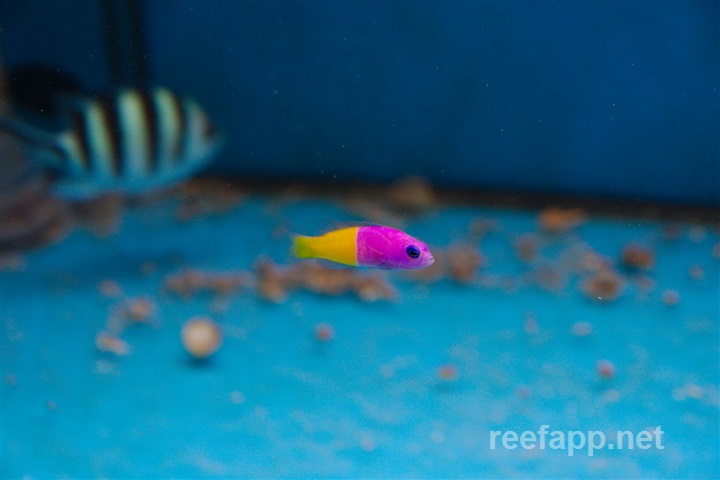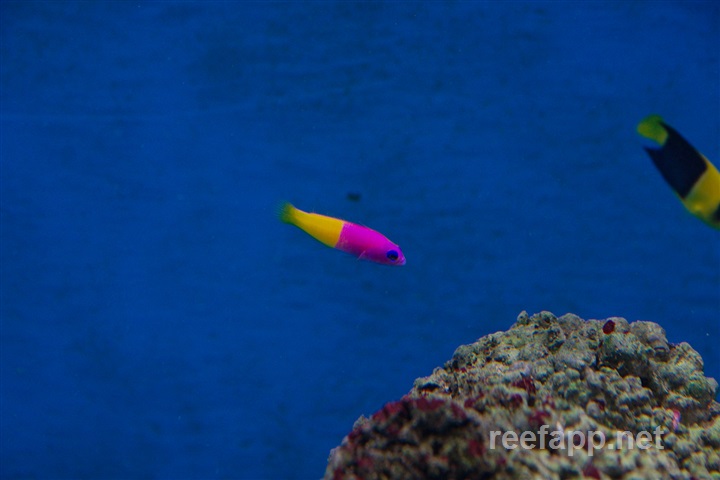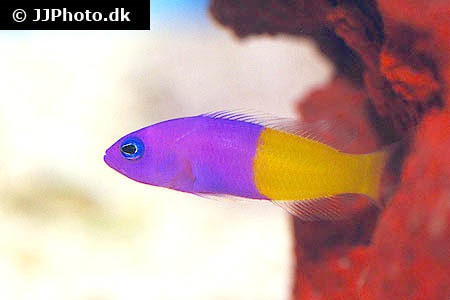Pictichromis paccagnellae




| Latin name | Pictichromis paccagnellae - (Axelrod, 1973) |
|---|---|
| Local name | Bicolor Dottyback |
| Family | Pseudochromidae - Pictichromis |
| Origin | Australia, Japan, Indonesia |
| Max length | 7 cm (2.8") |
| Minimum volume |
50 l (13 gal) |
|---|---|
| Hardiness |
Hardy |
| Suitable for aquarium |
Suitable with care |
| Reef safe |
Reef safe with caution |
| Aggressiveness | Aggressive towards other species |
| Recommended |
Small crustaceans (Krill, mysis, artemia...) Zooplankton (Cyclops, pods...) |
|---|---|
| Mostly |
Larger crustaceans (Shrimp, crabs...) |
This species is known to jump out of open aquaria.
This species poses a threat towards shrimps and crabs etc., which are relatively small.
This species can be extremely aggressive towards other fish.
Be careful when keeping these fish together with peaceful or docile species. Regular feeding, plenty of hiding places and a lot of space can alleviate aggressive behavior to some degree.
This species must be fed with an appropriately varied diet.
In the aquarium the colour of this species can become matte.
Food with plenty of pigment and generally a varied diet of high quality can help alleviate colour loss.
This species needs good hiding places, for example, between live rocks.
This species can change gender from female to male.
When a male is needed, a female changes sex and takes on the role.
This species can be bred in captivity, one can therefore consider asking your local fish store for a captive bred specimen.
Dottybacks (Pseudochromidae) are often very colourful, rather hardy and relatively small, typically under 4 inch (10 cm). These fish can be distinguished from other fish by looking at the shape of the eye, see for example the picture of this: Hawkfish, Surgeonfish, Rabbitfish, Angelfish, Triggerfish, Clown/ Damselfish or Pufferfish.
Dottybacks will compete for food with other fish which eat zooplankton off the rocks. Mandarinfish and similar species can find it difficult to get enough food if kept together with Dottybacks.
One could consider the Gramma species, if one wishes a similar fish which is more peaceful.
| Aquarium trade | Yes |
|---|---|
| Distribution | Western Pacific: Indonesia (Java and Sulawesi) to Vanuatu; Palau in Micronesia. |
| Danish common names |
Royal koralsmutte |
| English common names |
Royal dottyback |
Henry C. Schultz. 2002. The Dottybacks - Reefkeeping - (English)
Scott W. Michael. 2001. Basslets, Dottybacks & Hawkfishes: v. 2 (Reef Fishes) - TFH Publications / Microcosm Ltd. - (English)
Bob Fenner. The Dottybacks, Family Pseudochromidae - Wet Web Media - (English)
Collection of links to additional information - Wet Web Media - (English)

